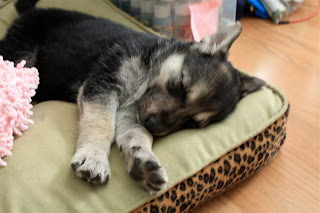Two well fed and happy dogs.
A large part of having a healthy happy pet is good nutrition. With good nutrition you can reduce the amount of waste your dog expels; improve skin, coat, and eye health; and improve your dogs overall quality of life. Just as is the case with human food, not all dog foods are created equal. It is important as a dog owner to know how to choose the right dog food for your pet by looking at the lists of ingredients and nutritional value label.
Like in human food, the ingredients are listed in the order of the largest quantity present to the least quantity present. Unless the dog food is vegetarian, the first ingredient should always be a real meat (i.e. Lamb, Beef, Chicken). Other ingredients to look for are brown rice or other whole grains; dried vegetables, like carrots; fruits, like blueberries; egg; and natural animal fats (indicated as chicken fat or poultry fat).
Here are some common dog food ingredients to avoid:
- Meat by-products, because by-product are undesired animal parts like organs bones, blood, intestine, lungs, ligaments, heads, feet, and feathers; which are lower in nutritional value and are not very digestible.
- Meat and bone meal, which is an inexpensive protein consisting mostly of poorly digestible bone materials.
- Animal Fat, which consists of generic fats and oils sometimes deemed too rancid for human consumption (identified fats like chicken or poultry fats is okay because it is naturally preserved).
- Corn, because it is difficult to digest for many dogs and can cause allergies, bloat, or gas.
- Food Fragments like brewers rice, which is a waste product of the alcohol industry.
- Sweeteners like corn syrup, sugar, and cane mallases; which can aggravate health problems such as diabetes.
Another important thing to look at is the percentage of protein and fat. Dogs need different amounts of protein and fat in their diet based on their breed, activity level, and age. Use the chart below to see how much protein and fat your dog needs.
Activity & Growth Stage Protein % Fat %
Puppy 28% 17%
Adult dog 18% 9-15%
Performance dog 25% 20%
Racing sled dog 35% 50%
Lactating dog 28% 17%
Have more questions about dog food nutrition? Visit these links for more information.









